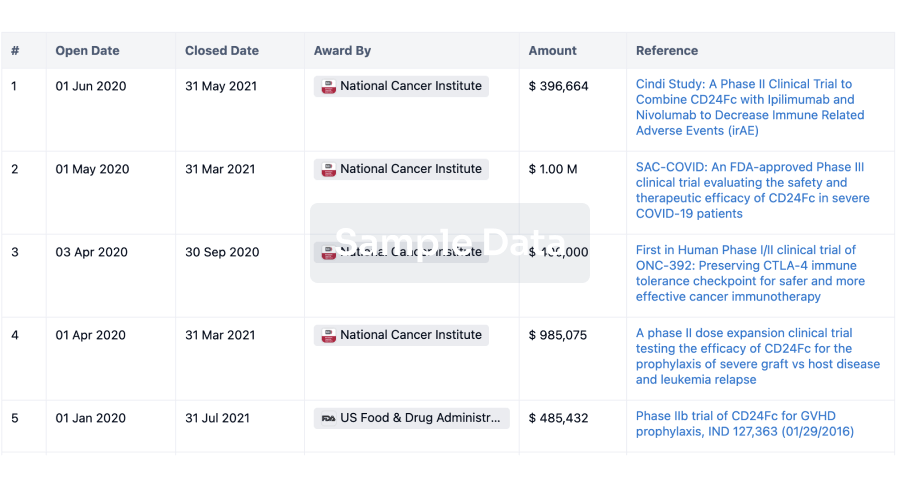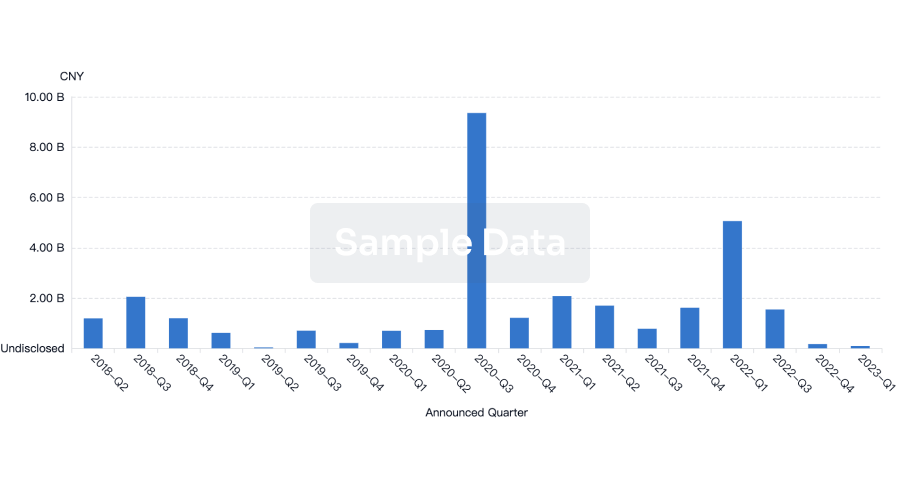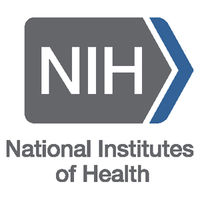Request Demo
Last update 14 Aug 2025

Medigen Vaccine Biologics Corp.
Last update 14 Aug 2025
Overview
Tags
Respiratory Diseases
Infectious Diseases
Prophylactic vaccine
Multivalent vaccine
Genetically engineered subunit vaccine
Disease domain score
A glimpse into the focused therapeutic areas
No Data
Technology Platform
Most used technologies in drug development
No Data
Targets
Most frequently developed targets
No Data
| Disease Domain | Count |
|---|---|
| Infectious Diseases | 2 |
| Top 5 Drug Type | Count |
|---|---|
| Prophylactic vaccine | 2 |
| Multivalent vaccine | 1 |
| Genetically engineered subunit vaccine | 1 |
| Top 5 Target | Count |
|---|---|
| SARS-CoV-2 S protein | 1 |
Related
2
Drugs associated with Medigen Vaccine Biologics Corp.Target |
Mechanism SARS-CoV-2 S protein inhibitors |
Active Org. |
Originator Org. |
Active Indication |
Inactive Indication |
Drug Highest PhaseApproved |
First Approval Ctry. / Loc. Taiwan Province |
First Approval Date17 Jul 2021 |
Target- |
Mechanism Immunostimulants |
Active Org. |
Originator Org. |
Inactive Indication- |
Drug Highest PhasePreclinical |
First Approval Ctry. / Loc.- |
First Approval Date- |
19
Clinical Trials associated with Medigen Vaccine Biologics Corp.NCT05198596
A Phase III, Parallel Group, Prospective, Randomized, Double-blind, Active-controlled, Two-arm, Multi-center Study to Evaluate the Immunogenicity, Safety, and Tolerability of MVC-COV1901 Compared to AZD1222 in Adult of 18 Years and Above
The purpose of this study is to assess the immunogenicity and safety of MVC- COV1901 vaccine compared to AZD1222 in heathy adults.
Start Date30 Jul 2022 |
Sponsor / Collaborator |
NCT05426343
A Phase III, Parallel-Group, Prospective, Randomized, Double-blind, Active-controlled, Two- Arm Study to Evaluate the Immunogenicity, Safety, and Tolerability of the MVC-COV1901 Compared to AZD1222 in Adult of 18 Years and Above.
The primary objective of the study is to measure the anti-SARS-CoV-2 neutralizing antibody titres in adult participants, in particular elderly, so as to demonstrate immunogenic superiority of MVC-COV1901 to the active control, AZD1222 vaccine, in terms of the GMT of neutralizing antibodies at 14 days after the second dose of the study intervention. This study also assesses the safety and tolerability of the study intervention and explores the immunogenicity in terms of antigen-specific immunoglobulin as well as the potential efficacy of MVC-COV1901 in preventing COVID-19.
Start Date09 Jul 2022 |
Sponsor / Collaborator |
NCT05216601
A Phase I, Prospective, Randomized, Open-labeled Study to Evaluate the Safety, Tolerability, and Immunogenicity of Booster Dose With MVC-COV1901 or MVC-COV1901(Beta) SARS-CoV-2 Vaccine in Adults
The purpose of this study is to assess the safety, tolerability, and immunogenicity of a booster dose of vaccine in participants who are generally healthy or with stable pre-existing health conditions. Study details include:
* The study duration per participant will be approximately 209 days (28 days screening, 1 day vaccination, and 180 days follow-up).
* The treatment duration will be 1 day. -The visit frequency will be 6 on-site visits (1 screening visit, 1 treatment visit, and 4 follow- up visits) and 1 phone visit.
* The study duration per participant will be approximately 209 days (28 days screening, 1 day vaccination, and 180 days follow-up).
* The treatment duration will be 1 day. -The visit frequency will be 6 on-site visits (1 screening visit, 1 treatment visit, and 4 follow- up visits) and 1 phone visit.
Start Date06 May 2022 |
Sponsor / Collaborator |
100 Clinical Results associated with Medigen Vaccine Biologics Corp.
Login to view more data
0 Patents (Medical) associated with Medigen Vaccine Biologics Corp.
Login to view more data
30
Literatures (Medical) associated with Medigen Vaccine Biologics Corp.01 Nov 2025·ENVIRONMENTAL RESEARCH
Spatiotemporal variations and risks assessment of PAH-bound suspended particles across different Asian countries: Insights from multi-city sampling and source apportionment
Article
Author: Chou, Charles C-K ; Tuyet-Hanh Tran, Thi ; Chi, Kai Hsien ; Lodoisamba, Sereeter ; Wu, Chih-Da ; Hsu, Yuan Cheng ; Pan, Shih Yu ; Chantara, Somporn ; Lodoisamba, Delgerzul ; Hsu, Yen-Shun ; Ngo, Tuan Hung ; Lin, Sheng-Lun
Air pollution caused by particulate matter (PM) poses serious health risks globally, particularly in rapidly urbanizing Asian cities, where extreme pollution episodes exhibit distinct chemical profiles and sources due to diverse local anthropogenic activities. This study aims to assess the toxicity and mutagenic characteristics of Polycyclic Aromatic Hydrocarbons (PAHs) originating from particulate matter (PM) in different anthropogenic actives in Asian cities. High-volume samplers were used for ambient PM collection in various Asian cities from 2019 to 2023, and subsequent analyses included PAHs, heavy metals, and water-soluble ions (WSIs). Ecological and inhalation cancer risk assessments were computed by multiplying concentrations of individual PAH compounds in Taipei, Chiang Mai, Hanoi, Ulaanbaatar, and Beijing, respectively. The average concentrations of PM2.5 and PAH BaP-TEQ levels were 132 ± 45.3 μg/m3, 23.0 ± 24.8 ng/m3 in Chiang Mai and 63.3 ± 11.9 μg/m3, 2.81 ± 2.64 ng/m3 in Hanoi, while 12.6 ± 6.02 μg/m3, 4.75 ± 8.88 ng/m3 in Taipei. In Ulaanbaatar, total suspended particles (TSP) and PAH levels during dust storm events were 2.08-8.13 times higher (TSP: 601 μg/m3, PAH: 91.0 ng/m3). Similarly, in Beijing, TSP and PAHs levels were 2.49-10.4 times higher during dust storm events (TSP: 701-1135 μg/m3, PAHs: 27.8 ± 24.6 ng/m3). PMF results revealed 47.5-79.8 % contributions from vehicles in Ulaanbaatar, Chiang Mai, and Hanoi. While ecological risk assessments indicated generally low toxicity (RI < 150), lifetime inhalation cancer risk (LICR) values exceeded the acceptable threshold (10-6) in several cities, highlighting the urgent need for targeted pollution control strategies.
01 Nov 2023·Journal of the Formosan Medical Association = Taiwan yi zhi
Immunogenicity and safety of heterologous mRNA-1273/MVC-COV1901 vaccination versus homologous mRNA1273 vaccination: A randomized, double-blind controlled study
Article
Author: Chen, Charles ; Liu, Wang-Da ; Pan, Sung-Ching ; Hsieh, Szu-Min ; Sun, Hsin-Yun ; Lien, Chia-En ; Huang, Yu-Shan ; Huang, Szu-Ting
BACKGROUND/PURPOSE:
MVC-COV1901 is a protein vaccine based on the same SARS-CoV-2 strain used in mRNA vaccine mRNA-1273. Data are lacking on immunogenicity and safety of MVC-COV1901 as heterologous boost for people already received one dose of mRNA-1273.
METHODS:
This is a randomized, double-blind trial that recruited adults aged 20-70 years who previously received a single dose of mRNA-1273 vaccine and were randomly assigned in a 1:1 ratio to receive a second dose with the homologous vaccine or protein-based MVC-COV1901 8-12 weeks after the first dose. The primary outcome was neutralizing antibody titers in terms of the geometric mean titer (GMT) 14 days after the second dose. Safety was assessed in all participants who received a dose of the study vaccine. The study is registered with ClinicalTrials.gov (NCT05079633).
RESULTS:
From September 30 to November 5, 2021, 144 participants were enrolled and randomly assigned to the MVC-COV1901 boost group (n = 72) or the mRNA-1273 boost group (n = 72). The neutralizing antibodies on Day 15 and the anti-SARS-CoV-2 IgG titers on Day 15 and 29 of homologous mRNA-1273 were significantly higher than those of heterologous mRNA-1273/MVC-COV1901. Cellular immune responses were comparable in both groups. However, adverse events were much more frequent after the mRNA-1273 boost than after the MVC-COV1901 boost.
CONCLUSION:
Our results show that heterologous boost with MVC-COV1901 yielded an inferior immunogenicity but significantly fewer adverse events, compared with homologous boost with mRNA-1273. In people experienced severe adverse events after prime dose of mRNA-1273, as well as in periods when the supply of mRNA-1273 is limited, MVC-COV1901 could serve as an acceptable alternative heterologous boost.
01 May 2023·Vaccine
Safety and immunogenicity of homologous versus heterologous booster dose with AZD1222, mRNA-1273, or MVC-COV1901 SARS-CoV-2 vaccines in adults: An observer-blinded, multi-center, phase 2 randomized trial
Article
Author: Lin, Ying-Chin ; En Lien, Chia ; Chen, Yen-Hsu ; Weng, Yi-Jen ; Estrada, Josue Antonio ; Torkehagen, Paal Fure ; Chen, Charles ; Cheng, Hao-Yuan ; Lin, Yi-Tsung ; Pan, Sung-Ching ; Hsieh, Szu-Min ; Estephan, Lila ; Waits, Alexander
OBJECTIVES:
To report the safety and immunogenicity profile of a protein subunit vaccine (MVC-COV1901) compared to AZD1222 and mRNA-1273 when given as a third (booster) dose to individuals who have completed different primary vaccine regimens.
METHODS:
Individuals were classified according to their primary vaccine regimens, including two-dose MVC-COV1901, AZD1222, or mRNA-1273. A third dose of either half-dose MVC-COV1901, full-dose MVC-COV1901, standard-dose AZD1222, half-dose mRNA-1273 was administered in a 1:1:1:1 treatment ratio to individuals with an interval range of 84-365 days after the second dose. Endpoints included safety, humoral immunogenicity, and cell-mediated immune response on trial days 15 and 29. Exploratory endpoint included testing against variants of concern (Omicron).
RESULTS:
Overall, 803 participants were randomized and boosted - 201 received half-dose MVC-COV1901, 196 received full-dose MVC-COV1901, 203 received AZD1222, and 203 received half-dose mRNA-1273. Reactogenicity was mild to moderate, and less in the MVC-COV1901 booster group. Heterologous boosting provided the best immunogenic response. Boosting with mRNA-1273 in MVC-COV1901 primed individuals induced the highest antibody titers, even against Omicron, and cell-mediated immune response.
CONCLUSIONS:
Overall, MVC-COV1901 as a booster showed the best safety profiles. MVC-COV1901 as a primary series, with either homologous or heterologous booster, elicited the highest immunogenic response.
CLINICALTRIALS:
gov registration NCT05197153.
3
News (Medical) associated with Medigen Vaccine Biologics Corp.29 Aug 2023
The World Health Organization has
secured
licensing agreements with Medigen Vaccine Biologics, the University of Chile and the Spanish National Research Council (CSIC) to increase the number of Covid-19 vaccine and assay product options for worldwide use. The licensing agreements fall under WHO’s Covid-19 Technology Access Pool (C-TAP).
Medigen is the first private manufacturer, as well as the first vaccine maker, to enter an agreement with C-TAP. The Taiwan-based biotech is licensing its Covid-19 vaccine, MVC COVID-19, and providing staff training to manufacturers. The protein subunit vaccine, which has emergency use authorization in Taiwan, has had three million doses administered in seven countries, according to a WHO press release.
VaccineLicense out/inEmergency Use AuthorizationmRNA
23 Feb 2021
Chinese fusion protein company Clover Biopharmaceuticals raised a $230 million series C round co-led by GL Ventures and Temasek, which will push its COVID-19 vaccine into Phase II/III testing and production planning.
Chinese fusion protein company Clover Biopharmaceuticals raised a $230 million series C round co-led by GL Ventures and Temasek, which will push its COVID-19 vaccine into Phase II/III testing and production planning.
The funding will also back development of a next-generation vaccine program against SAR-CoV-2 variants, and several other recombinant trimeric fusion protein-based vaccines and cancer therapeutics targeting previously undruggable pathways. New investors Oceanpine Capital and OrbiMed, and existing investor Delos Capital, joined the venture round.
The company announced positive Phase I safety and tolerability data for its two COVID-19 SCB-2019 S-Trimer vaccine candidates in December, which were formulated with from Dynavax’s CpG 1018 adjuvant and GlaxoSmithKline’s pandemic adjuvant system, respectively.
Although Phase II/III efficacy trials for both were announced at the time, Clover
announced
earlier this month it would terminate its GSK partnership and move forward only with the Dynavax collaboration. While Clover did not elaborate on the move, safety data
published
in January in
The Lancet
showed patients receiving Dynavax’s adjuvant had fewer systemic adverse events following the second dose.
Dynavax’s adjuvant has also been tapped by Medigen Vaccine Biologics for its COVID-19 vaccine candidate, MVC-COV1901, currently in Phase II testing.
The Phase II/III trial will be supported by $99 million from the Coalition for Epidemic Preparedness Innovations (CEPI). CEPI had previously funded the Phase I trials
last year
, to the tune of $69.5 million. It has said it may commit up to $328 million in total.
Clover’s technology is based on covalently-trimerized fusion proteins, allowing it to target difficult disease pathways like the tumor necrosis factor (TNF) superfamily, which is involved in cancer, immune function and infection.
The company has at least five other vaccine programs in development based on trimeric fusion proteins, including a multivalent SARS-CoV-2 vaccine that could protect against multiple variants to rabies, plus vaccine candidates against HIV/AIDS, influenza, rabies and respiratory syncytial virus.
Another area of focus for Clover is cancer immunotherapy, where its lead asset is SCB-313, a human TNF-related apoptosis-inducing ligand (TRAIL)-based trimeric fusion protein therapy. SCB-313 is currently in Phase I testing for malignant ascites and pleural effusions, and for peritoneal carcinomatosis. It has at least two other cancer therapies in preclinical development.
Clover said the funding would advance several of its pipeline products into the clinic this 2021, plus boost its R&D and commercial biomanufacturing capabilities.
Clover is also developing Fc-fusion protein-based biosimilars. Its lead candidate is a biosimilar for Embrel, currently in Phase III testing for ankylosing spondylitis and rheumatoid arthritis.
VaccinePhase 1Phase 2ImmunotherapyPhase 3
25 Jan 2021
MIMIX patch is designed to deliver medicines and vaccines through multiple tiny and painless projections
Vaxess has secured NSF and DARPA funding for the development of refrigeration-free vaccine patch. (Credit: MasterTux from Pixabay)
US-based biotechnology firm Vaxess Technologies has secured funding from National Science Foundation (NSF) and a subcontract from the US Defense Advanced Research Projects Agency (DARPA) to develop mRNA-based single-dose and refrigeration-free vaccine patch.
The funding will be provided to two separate projects that will mainly focus on the development of mRNA-based vaccines and other medical countermeasures with the ability to bypass the cold-chain in a painless patch format.
Based on the achievement of all milestones, total funding will be provided up to $2m, including a $256,000 phase I SBIR grant from the NSF.
Vaxess will use the financing to enhance administration of new mRNA-based vaccines and other medical countermeasures.
The company will incorporate mRNA-based vaccines and gene modulators through a collaboration with the Santangelo Lab at Georgia Tech into MIMIX patches for the administration of the vaccines.
MIMIX is painless and shelf-stable patch
MIMIX is a painless and shelf-stable patch that uses a patented sustained release technology. The patch, which can be self-applied, will help improve protection.
The patch is designed to deliver medicines and vaccines through multiple tiny and painless projections, which dissolve at an accurate engineered rate and release the treatment at its most effective dose.
Silk Protein Matrix patented technology allows the patch to avoid the use of ultra-cold chain logistics, thereby helping to easily distribute in times of pandemic outbreaks.
In addition, the patch is compatible with a range of Covid-19 vaccine candidates.
Vaxess co-founder Livio Valenti said: “Funding from the NSF and DARPA represent a renewed commitment from the Federal Government to support the development of novel vaccines to combat the current pandemic and future threats.
“Vaxess will continue to be a source of innovation to address some of the most pressing challenges we are facing today and in the years to come.”
In September 2020, Vaxess Technologies joined forces with Medigen Vaccine Biologics (MVC) to develop a combined Covid-19 and influenza vaccine patch.
VaccinemRNA
100 Deals associated with Medigen Vaccine Biologics Corp.
Login to view more data
100 Translational Medicine associated with Medigen Vaccine Biologics Corp.
Login to view more data
Corporation Tree
Boost your research with our corporation tree data.
login
or

Pipeline
Pipeline Snapshot as of 16 Aug 2025
The statistics for drugs in the Pipeline is the current organization and its subsidiaries are counted as organizations,Early Phase 1 is incorporated into Phase 1, Phase 1/2 is incorporated into phase 2, and phase 2/3 is incorporated into phase 3
Preclinical
1
1
Approved
Other
6
Login to view more data
Current Projects
Login to view more data
Deal
Boost your decision using our deal data.
login
or

Translational Medicine
Boost your research with our translational medicine data.
login
or

Profit
Explore the financial positions of over 360K organizations with Synapse.
login
or

Grant & Funding(NIH)
Access more than 2 million grant and funding information to elevate your research journey.
login
or

Investment
Gain insights on the latest company investments from start-ups to established corporations.
login
or

Financing
Unearth financing trends to validate and advance investment opportunities.
login
or

AI Agents Built for Biopharma Breakthroughs
Accelerate discovery. Empower decisions. Transform outcomes.
Get started for free today!
Accelerate Strategic R&D decision making with Synapse, PatSnap’s AI-powered Connected Innovation Intelligence Platform Built for Life Sciences Professionals.
Start your data trial now!
Synapse data is also accessible to external entities via APIs or data packages. Empower better decisions with the latest in pharmaceutical intelligence.
Bio
Bio Sequences Search & Analysis
Sign up for free
Chemical
Chemical Structures Search & Analysis
Sign up for free


